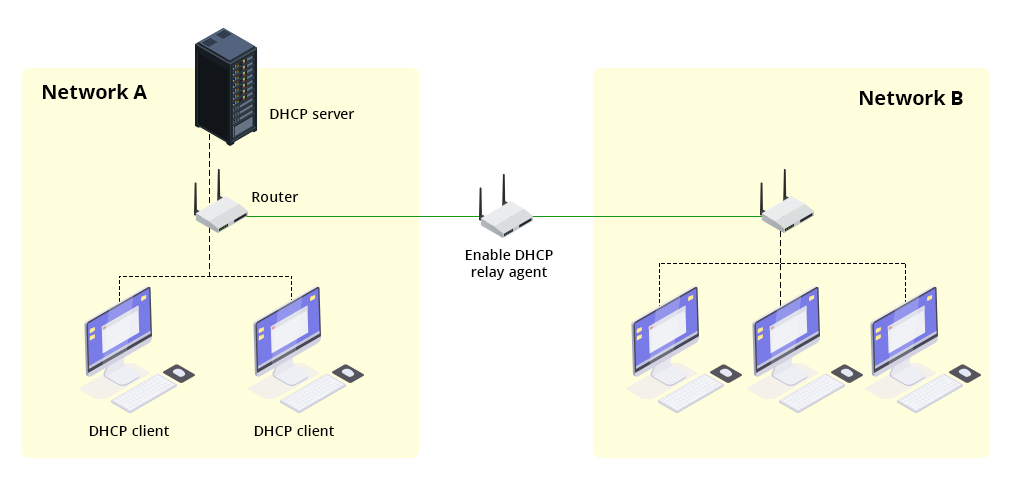Dynamic Host Configuration Protocol (DHCP) is a network management protocol that empowers the DHCP network servers to dynamically allocate IPs and other network configuration parameters such as subnet masks, default gateways and DNS servers to the devices requesting for it, without manual intervention. This DHCP protocol works in a client-server model, where the IPs are allocated only to DHCP enabled client devices. This ensures that the DHCP servers manage the network seamlessly, significantly reducing errors caused by manual allocation, such as IP conflicts and improper IP usage.
But have you ever wondered how DHCP servers allocates IPs effortlessly? The DHCP servers allocates IPs and other configuration parameters to various DHCP-enabled clients in the network through a process called DHCP DORA process. DORA stands for Discover, Offer, Request and Acknowledge, each representing a step in the process of fetching IP address from DHCP server. The DORA process is a significant aspect of DHCP server operation, as its automation is invaluable for managing larger networks. Now that we know the DHCP servers use DORA process to automate IP allocations, let's get this DHCP DORA explained in simple terms.
As noted earlier, DHCP DORA is a 4 step process and let's see what are the 4 steps of DORA in DHCP server operation.
This is the 4 steps DORA process in DHCP servers.
Now, can you imagine a situation where there is no DHCP server in a particular network segment.
A DHCP relay agent is introduced in such scenarios to overcome this challenge.
We know that a huge network is divided into multiple segments, each operating as a separate network. A device can send a broadcast message only to DHCP servers within its own network; it cannot send it across subnets or other networks. A DHCP relay agent serves as a communication gateway between a network with DHCP server and a network without one. In simpler words, a DHCP relay agent facilitates communication between DHCP servers and DHCP clients, each from different network.
Let's imagine two separate networks - network A and network B. Say network A has DHCP server and network B doesn't.
Here's how the DORA process works in such a scenario.
Installing a relay agent isn't ideal for all types of networks. Using a separate DHCP server in Network B introduces higher costs and increased management overhead compared to configuring a relay agent, which can be a device within the network or the network router itself, making the process much simpler.

This process is essential for automating IP allocations and configurations, enabling effective communication between DHCP-enabled client devices and DHCP servers. Automatic IP allocations not only ensures seamless network operation but also guarantees effective usage of available IPs. The DORA process minimizes the risk of IP conflicts. The centralization adapted by the DORA process simplifies network management tasks, thereby reducing administrative overhead and potential configuration errors.
Without proper monitoring, troubleshooting and resolving DHCP server related issues becomes challenging. Hence, using a versatile DHCP monitoring software can help you overcome these challenges.
With ManageEngine OpUtils, you can monitor complex network architectures with multiple DHCP servers, from a single console.
OpUtils is a comprehensive IP address management and switch port mapper tool that has in-built capabilities of monitoring DHCP servers. It integrates seamlessly with popular DHCP servers, thereby letting you effectively monitor them.
Discover a wide range of DHCP servers into OpUtils console. With just a few clicks, you can add your DHCP servers to the console and start monitoring them immediately.
Monitor DHCP servers, their scopes, and associated IPs - all from a single console. This provides a comprehensive overview of server details and IP information, including Total IPs, Leased IPs, and DHCP IP pool utilization. This helps network administrators plan well in advance and maintain specific metrics for the server and scope individually.
A well-equipped utilization threshold-based alert mechanism notifies administrators of any issues related to DHCP servers through syslog and email. This allows administrators to monitor the server's capacity and plan meticulously.
The numerous reports helps track DHCP server activity. You can also create various reports to monitor your network activity.
OpUtils supports various DHCP servers, including:
OpUtils seamlessly integrates with DHCP servers, ensuring a unified approach that allows administrators to monitor the servers from time to time and enhance its performance.
Download 30 days free trial of OpUtils or schedule a personalized demo with us now to learn how DHCP server monitoring can enhance your network management strategies.
